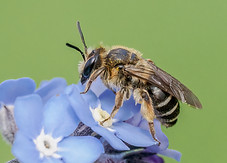Small World Discoveries
by Tony Enticknap - tickspics
Focusing on insects, arachnids and other small nature subjects from East Dorset and the New Forest ...
APOCRITA | Aculeata > Apoidea
Bees are initially grouped with the non-parasitic wasps and ants within the Aculeata (stinging species) subdivision of the Hymenoptera 'wasp-waisted' suborder Apocrita. The species are then split into various taxonomic groups with bees being placed together with the closely related sphecid wasps within superfamily Apoidea.
Unfortunately, classification from there becomes more complicated as some authorities prefer a single-family approach broken down into subfamilies whilst others, notably the BWARS (Bees, Wasps and Ants Recording Scheme), utilise the six-family system as shown below. The same system is used in the primary field guide 'Bees of Great Britain and Ireland' by Steven Falk and also 'Solitary Bees' by Ted Benton.
The British list recognises around 270 species of bee with the most well-known being the honeybee and the bumblebees of which there are 25 extant species. These are the social bees that live in large colonies. The remaining 240 or so species are solitary bees. Their lifestyles are varied, and although the majority collect pollen and build their own nests, many are cleptoparasites.
Clicking any of the photos below takes you to a brief 'species account' and to further images that can be enlarged.
Colletidae
Andrenidae
Halicidae
Melittidae
Megachilidae
Apidae
Original list created Oct.21 | updated March 25 (v.7)









































-2.jpg)














